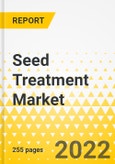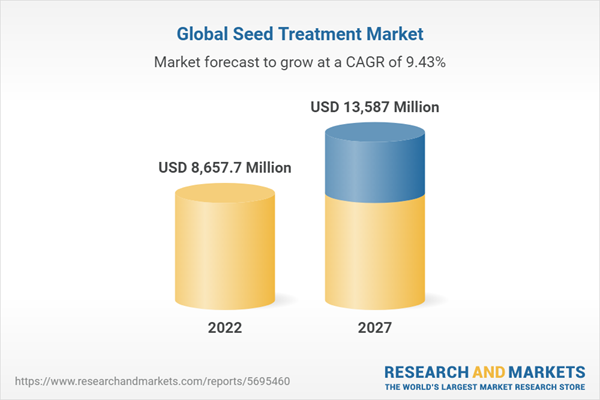Growing Demand for Coated Organic Seeds
This report comes with 10% free customization, enabling you to add data that meets your specific business needs.
The seed treatment market was valued at $7,924.6 million in 2021, which is expected to grow with a CAGR of 9.43% and reach $13,587.0 million by 2027. The growth in the global seed treatment market is expected to be driven by increasing seed and soil-borne diseases and the growing demand for treated seeds.
Market Lifecycle Stage
The seed treatment market is in the development phase. Increased research and development activities are underway to develop treated seeds, biological seed treatment products, and seed pelleting techniques, which are expected to increase the demand for seed treatment in farming practices.
Increasing investments in the R&D of seed treatment is one of the major opportunities in the global seed treatment market. Moreover, the functions of seed treatment such as seed protection, seedling protection, and seed germination are attracting seed manufacturers, farmers, and animal feed producers.
Impact
- With an increasing precision farming and a rise in seed-borne diseases creating the market opportunity for seed treatment manufacturers. As seed treatment saves the cost in farming practices and enhances seed germination, farmers are adopting seed treatment in their farming practices. Also, North America and Europe are adopting the Agriculture 4.0 revolution trend and increasing biological seed treatment products in farming practices. This creates better opportunities in North American and European markets.
- Additionally, seed treatment products are used in various crop types including oilseeds, cereals & grains, and fruits & vegetables. The growing demand for treated seeds furthermore drives the seed treatment market during the forecast period 2022-2027.
Impact of COVID-19
COVID-19 pandemic directly impacted on manufacturing and transportation activities of the seed treatment market. Due to the pandemic, the supply chain of the seed treatment market was disturbed at the global level. Various governments closed their international trades and production units, due to these seed treatment markets being hampered more at the global level. In mid of 2021, manufacturing and transportation activities of the seed treatment started gradually, and international trades started efficiently. Therefore, the production and consumption of seed treatment products are expected to increase post-COVID-19 pandemic.
Market Segmentation
Segmentation 1: by Application Technique
- Seed Coating
- Seed Dressing
- Seed Pelleting
The global seed treatment market in the application technique segment is expected to be dominated by the seed coating application technique. All treated seeds are mass-produced and are used seed treatment products for seed coating application techniques commonly in developing counties.
Segmentation 2: by Crop Type
- Oilseeds
- Cereals & Grains
- Fruits & Vegetables
- Others
The global seed treatment market in the crop type is expected to be dominated by cereals and grains crop type. The cereals and grains include rice, wheat, corn, sorghum, and barely. The growing demand of cereals & grains, and the rise in awareness of treated cereals & grains seeds further drive the seed treatment market in near future.
Segmentation 3: by Product Type
- Chemical Seed Treatment
- Non-Chemical Seed Treatment
The global seed treatment market is dominated by the chemical seed treatment segment. Chemical seed treatment includes insecticide, fungicide, nematicide, fertilizer, plant growth nutrients, or a combination of crop protection chemicals. The growing demand for high-value insecticide and fungicide seed treatment products are driving the chemical seed treatment market globally.
Segmentation 4: by Formulation
- Liquid Solution
- Powder
- Emulsion
- Flowable Concentrate
- Water Dispersible Powder for Slurry
- Others
The global seed treatment market is dominated by the liquid solution segment. Due to the ease of use and high effectiveness of seed treatment products, liquid solution seed treatment products are booming in the market. The increasing acceptance of biological seed treatment products and organic farming practices are driving the growth of the liquid solution formulation.
Segmentation 5: by Function
- Seed Protection
- Seed Enhancement
The seed treatment market differentiates depending on its functionality. Based on functionality, the seed treatment market is segmented into two major types, including seed protection and seed enhancement. Seed protection is a primarily important function because it enables the plant to imbibe certain beneficial properties prior to germination.
Segmentation 6: by Region
- North America - U.S., Canada, and Mexico
- Europe - Germany, France, Italy, Spain, Netherlands, and Rest-of-Europe
- China
- U.K.
- Asia-Pacific and Japan - Japan, India, Australia, Malaysia, and Rest-of-Asia-Pacific and Japan
- South America - Brazil, Argentina, Rest-of-South America
- Middle East and Africa - South Africa, Middle East, Kenya, and Rest-of-Middle East and Africa
North America generated the highest revenue of $2.41 billion in 2021, which is attributed to the R&D advancements and supporting government regulations in the North America region. North America is an attractive region for the biological seed treatment market because of the increasing demand for organic food and precision farming.
Recent Developments in Global Seed Treatment Market
- In April 2022, BASF SE opened a new center for sustainable agriculture in North America. This center is expected to increase its biological seed treatment product portfolio in North America. Due to this, the company creates awareness among the farmers and increases its biological seed treatment sales in the U.S., Canada, and Mexico.
- In May 2022, Bayer Vietnam launched Routine Start 280FS, a seed germination product for rice seeds. The growing rice seed-borne diseases and increasing rice cultivation create a demand for rice seed treatment products in Vietnam. Thus, Bayer Vietnam strategically launched a seed treatment product for rice crop in Vietnam.
- In February 2022, Croda International Plc partnered with Xampla, to create biodegradable and microplastic-free seed coatings technology. Due to this partnership, the company focuses on research and development activities and intends to pioneer in biodegradable and microplastic-free seed coatings technology in the global seed treatment market.
- In May 2022, Corteva Agriscience established its Centre for Seed Applied Technologies (CSAT) laboratory in Rosslyn. This helps Corteva Agriscience to increase its seed treatment business in Africa and Middle East countries.
- In May 2022, Syngenta launched the VICTRATO seed treatment product. This product protects soybeans, corn, cereals, cotton, and rice seeds from soil-borne fungal diseases.
Demand - Drivers and Limitations
Following are the demand drivers for the seed treatment market:
- Increased Usage of Commercial Seeds
- Growing Demand for Coated Organic Seeds
- Reduced Risk of Exceeding MRLs
The market is expected to face some limitations too due to the following challenges:
- Stringent Government Regulations
- Lower Shelf Life and High Maintenance
How can this report add value to an organization?
Product/Innovation Strategy: The product segment helps the reader understand the different types of seed treatment available for deployment in the various crop types including wheat, maize, soybean, canola, cotton, rice, sorghum, solanaceae, leafy vegetables, cucurbits, brassicas, root & bulb vegetables and forage crops globally.
Moreover, the study provides the reader with a detailed understanding of the different seed treatments by application techniques (seed coating, seed pelleting, and seed dressing), by Product type (chemical seed treatment and non-chemical seed treatment), by formulation (liquid solution, powder, emulsion, flowable concentrate, water dispersible powder for slurry, others), and by function (seed protection and seed enhancement). Seed treatment finished products generate higher revenues when compared to the operational and raw material costs. Therefore, the seed treatment business is a high revenue-generating business.
Growth/Marketing Strategy: The global seed treatment market has seen major development by key players operating in the market, such as product launches, business expansion, partnerships, collaboration, and joint ventures. The favored strategy for the companies has been new product launches, joint ventures, and partnerships to strengthen their position in the seed treatment market. For instance, in March 2022, Syngenta launched CruiserMaxx APX soybean seed treatment solution. This product is registered by the U.S. Environmental Protection Agency. Due to this approval, the company will increase its market share in the global seed treatment market.
Competitive Strategy: Key players in the global seed treatment market analyzed and profiled in the study. Moreover, a detailed competitive benchmarking of the players operating in the global seed treatment market has been done to help the reader understand how players stack against each other, presenting a clear market landscape. Additionally, comprehensive competitive strategies such as partnerships, agreements, and collaborations will aid the reader in understanding the untapped revenue pockets in the market.
Key Market Players and Competition Synopsis
The companies that are profiled have been selected based on inputs gathered from primary experts and analyzing company coverage, product portfolio, and market penetration.
The top segment players which are leading include seed treatment public companies, that capture around 60% of the presence in the market. Private players in seed treatment industries account for approximately 40% of the presence in the market.
Some of the prominent names established in this market are:
Company Type 1: Public Company
- ADAMA
- BASF SE
- Bayer AG
- Croda International Plc
- DuPont
- Eastman Chemical Company
- FMC Corporation
- Nufarm
- Solvay
- Sumitomo Chemical Co., Ltd.
- Syngenta
- UPL
Company Type 2: Private Company
- Agrauxine
- BioWorks
Company Type 3: Start-up Company
- Andes
- SilviBio
- SeedEFE
- Inari Agriculture Inc
- Ad Terram
Companies that are not a part of the above-mentioned pool have been well represented across different sections of the report (wherever applicable).
Table of Contents
Companies Mentioned
- ADAMA
- BASF SE
- Bayer AG
- Croda International Plc
- DuPont
- Eastman Chemical Company
- FMC Corporation
- Nufarm
- Solvay
- Sumitomo Chemical Co., Ltd.
- Syngenta
- UPL
- Agrauxine
- BioWorks
- Andes
- SilviBio
- SeedEFE
- Inari Agriculture Inc
- Ad Terram
Table Information
| Report Attribute | Details |
|---|---|
| No. of Pages | 255 |
| Published | November 2022 |
| Forecast Period | 2022 - 2027 |
| Estimated Market Value ( USD | $ 8657.7 Million |
| Forecasted Market Value ( USD | $ 13587 Million |
| Compound Annual Growth Rate | 9.4% |
| Regions Covered | Global |
| No. of Companies Mentioned | 19 |









